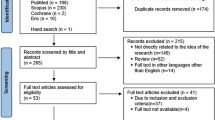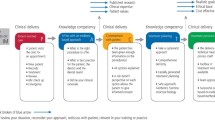Abstract
Introduction As an attempt to provide supporting evidence for the formulation of future educational strategies on knowledge translation, this systematic review assessed and synthesised the available evidence related to the dentists' awareness, perceived and actual knowledge of evidence-based dentistry (EBD) principles, methods and practices.
Methods Primary studies that considered dentists' reports collected from interviews, questionnaires, or conversation sessions were selected. Studies enrolling students, dental hygienists, or other health professionals were not included. Reviews, editorials, letters, study protocols, articles presenting knowledge translation strategies and initiatives, examples of EBD approaches to specific clinical questions, and guidelines focused on EBD implementation were also excluded. Cochrane, Embase, PubMed, Scopus and Web of Science databases were searched. Grey literature was partially covered by the Google Scholar search and the reference lists of the pre-selected studies. The study search was concluded in February 2021. Descriptive data of the selected studies were synthesised, and the risk of bias was assessed according to the National Institutes of Health Quality Assessment Tool for observational cohort and cross-sectional studies.
Results Twenty-one articles were included. High percentages of dentists were aware of EBD. Variable proportions of professionals declared to have some understanding of EBD, although few presented actual knowledge of principles, methods and practices.
Discussion Methodologically, most studies presented limitations regarding sample representativity, participation rates, detailing of the outcome measures, and validation of the assessment tools. Additionally, extensive overall ranges of responses were often observed across the studies, possibly as a result of heterogeneity across samples and assessment tools. The authors thus suggest developing valid questionnaires including all dimensions (awareness, perceived knowledge and actual knowledge) within an assessment tool. This would contribute to establishing knowledge translation strategies to overcome specific gaps in EBD knowledge.
This is a preview of subscription content, access via your institution
Access options
Subscribe to this journal
Receive 4 print issues and online access
$259.00 per year
only $64.75 per issue
Buy this article
- Purchase on Springer Link
- Instant access to full article PDF
Prices may be subject to local taxes which are calculated during checkout

Similar content being viewed by others
References
Sackett D L, Rosenberg W M, Grey J A, Haynes R B, Richardson W S. Evidence based medicine: what it is and what it isn't. BMJ 1996; 312: 71-72.
Iqbal A, Glenny A M. General dental practitioners' knowledge of and attitudes towards evidence based practice. Br Dent J 2002; 193: 587-591.
Linnebur S A, Ellis S L, Astroth J D. Educational practices regarding anticoagulation and dental procedures in U S. dental schools. J Dent Educ 2007; 71: 296-303.
McGlone P, Watt R, Sheiham A. Evidence-based dentistry: an overview of the challenges in changing professional practice. Br Dent J 2001; 190: 636-639.
Neuppmann Feres M F, Roscoe M G, Job S A, Mamani J B, Canto G D L, Flores-Mir C. Barriers involved in the application of evidence-based dentistry principles: A systematic review. J Am Dent Assoc 2020; DOI: 10.1016/j.adaj.2019.08.011.
Ahad M, Sukumaran G. Awareness, attitude and knowledge about evidence based dentistry among the dental practitioner in Chennai city. Res J Pharm Technol 2016; 9: 1863-1866.
Al-Ansari A, ElTantawi M. Factors affecting self-reported implementation of evidence-based practice among a group of dentists. J Evid Based Dent Pract 2014; 14: 2-8.
Gupta M, Bhambal A, Saxena S, Sharva V, Bansal V, Thakur B. Awareness, Attitude and Barriers Towards Evidence Based Dental Practice Among Practicing Dentists of Bhopal City. J Clin Diagn Res 2015; DOI: 10.7860/JCDR/2015/12814.6342.
Rabe P, Holmen A, Sjogren P. Attitudes, awareness and perceptions on evidence based dentistry and scientific publications among dental professionals in the county of Halland, Sweden: a questionnaire survey. Swed Dent J 2007; 31: 113-120.
ALmalki W D, Ingle N, Assery M, Alsanea J. Dentists' Knowledge, Attitude, and Practice Regarding Evidence-Based Dentistry Practice in Riyadh, Saudi Arabia. J Pharm Bioallied Sci 2019; DOI: 10.4103/jpbs.JPBS_247_18.
Yamalik N, Nemli S K, Carrilho E et al. Implementation of evidence-based dentistry into practice: analysis of awareness, perceptions and attitudes of dentists in the World Dental Federation-European Regional Organisation zone. Int Dent J 2015; 65: 127-145.
Yusof Z Y, Han L J, San P P, Ramli A S. Evidence-based practice among a group of Malaysian dental practitioners. J Dent Educ 2008; 72: 1333-1342.
Trevethan R. Deconstructing and Assessing Knowledge and Awareness in Public Health Research. Front Public Health 2017; 5: 194.
Haynes B, Haynes G A. ACP Journal Club. What does it take to put an ugly fact through the heart of a beautiful hypothesis? Evid Based Med 2009; 14: 68-69.
Madhavji A, Araujo E A, Kim K B, Buschang P H. Attitudes, awareness, and barriers toward evidence-based practice in orthodontics. Am J Orthod Dentofacial Orthop 2011; DOI: 10.1016/j.ajodo.2010.05.023.
Page M, McKenzie J, Bossuyt P et al. The PRISMA 2020 statement: an updated guideline for reporting systematic reviews. PLoS Med 2021; DOI: 10.1371/journal.pmed.1003583.
National Heart, Lung, and Blood Institute. Quality Assessment Tool for Observational Cohort and Cross-Sectional Studies. 2021. Available at https://www.nhlbi.nih.gov/health-topics/study-quality-assessment-tools (accessed August 2021).
Afrashtehfar K I, Eimar H, Yassine R, Abi-Nader S, Tamimi F. Evidence-based dentistry for planning restorative treatments: barriers and potential solutions. Eur J Dent Educ 2017; DOI: 10.1111/eje.12208.
Guncu G N, Nemli S K, Carrilho E et al. Clinical Guidelines and Implementation into Daily Dental Practice. Acta Med Port 2018; 31: 12-21.
Haron I M, Sabti M Y, Omar R. Awareness, knowledge and practice of evidence-based dentistry among dentists in Kuwait. Eur J Dent Educ 2012; DOI: 10.1111/j.1600-0579.2010.00673.x.
Qureshi A, Bokhari S A, Pirvani M, Dawani N. Understanding and practice of evidence based search strategy among postgraduate dental students: a preliminary study. J Evid Based Dent Pract 2015; 15: 44-49.
Vahabi S, Namdari M, Vatankhah M, Khosravi K. Evidence-Based Dentistry Among Iranian General Dentists and Specialists: A Knowledge, Attitude, and Practice Study. Iran Red Crescent Med J 2020; 22: 1-7.
Rawat P, Goswami R P, Kaur G, Vyas T, Sharma N, Singh A. Knowledge, Attitude, and Behaviour toward Evidence-based Dentistry among Dental Professionals in Jodhpur Rajasthan, India. J Contemp Dent Pract 2018; 19: 1140-1146.
Ciancio M J, Lee M M, Krumdick N D, Lencioni C, Kanjirath P P. Self-Perceived Knowledge, Skills, Attitudes, and Use of Evidence-Based Dentistry Among Practitioners Transitioning to Dental Educators. J Dent Educ 2017; 81: 271-277.
Sabounchi S S, Nouri M, Erfani N, Houshmand B, Khoshnevisan M H. Knowledge and attitude of dental faculty members towards evidence-based dentistry in Iran. Eur J Dent Educ 2013; 17: 127-137.
Straub-Morarend C L, Marshall T A, Holmes D C, Finkelstein M W. Toward defining dentists' evidence-based practice: influence of decade of dental school graduation and scope of practice on implementation and perceived obstacles. J Dent Educ 2013; 77: 137-145.
Wudrich K M, Matthews D C, Brillant M S, Hamdan N M. Knowledge Translation Among General Dental Practitioners in the Field of Periodontics. J Can Dent Assoc 2020; 86: k5.
Pau A, Omar H, Khan S, Jassim A, Seow L L, Toh C G. Factors associated with faculty participation in research activities in dental schools. Singapore Dent J 2017; 38: 45-54.
Hinton R J, McCann A L, Schneiderman E D, Dechow P C. The winds of change revisited: progress towards building a culture of evidence-based dentistry. J Dent Educ 2015; 79: 499-509.
McCallum J M, Arekere D M, Green B L, Katz R V, Rivers B M. Awareness and knowledge of the U S. Public Health Service syphilis study at Tuskegee: implications for biomedical research. J Health Care Poor Underserved 2006; 17: 716-733.
Falagas M E, Pitsouni E I, Malietzis G A, Pappas G. Comparison of PubMed, Scopus, Web of Science, and Google Scholar: strengths and weaknesses. FASEB J 2008; 22: 338-342.
Chang M J, Chang Y J, Kuo S H, Yang Y H, Chou F H. Relationships between critical thinking ability and nursing competence in clinical nurses. J Clin Nurs 2011; 20: 3224-3232.
Ross D, Schipper S, Westbury C et al. Examining Critical Thinking Skills in Family Medicine Residents. Fam Med 2016; 48: 121-126.
Chambers D, Wilson P M, Thompson C A, Hanbury A, Farley K, Light K. Maximizing the impact of systematic reviews in health care decision making: a systematic scoping review of knowledge-translation resources. Milbank Q 2011; 89: 131-156.
Song M, Spallek H, Polk D, Schleyer T, Wali T. How information systems should support the information needs of general dentists in clinical settings: suggestions from a qualitative study. BMC Med Inform Decis Mak 2010; 10: 7.
Chalmers I, Haynes B. Reporting, updating, and correcting systematic reviews of the effects of health care. BMJ 1994; 309: 862-865.
Tricco A C, Cardoso R, Thomas S M et al. Barriers and facilitators to uptake of systematic reviews by policy makers and health care managers: a scoping review. Implement Sci 2016; 11: 4.
Woolf S H, Grol R, Hutchinson A, Eccles M, Grimshaw J. Clinical guidelines: potential benefits, limitations, and harms of clinical guidelines. BMJ 1999; 318: 527-530.
Faggion Jr C M. Clinician assessment of guidelines that support common dental procedures. J Evid Based Dent Pract 2008; 8: 1-7.
Glenny A M, Worthington H V, Clarkson J E, Esposito M. The appraisal of clinical guidelines in dentistry. Eur J Oral Implantol 2009; 2: 135-143.
Shah P, Moles D R, Parekh S, Ashley P, Siddik D. Evaluation of paediatric dentistry guidelines using the AGREE instrument. Paediatr Dent 2011; 33: 120-129.
Brouwers M C, Kerkvliet K, Spithoff K, Consortium A N S. The A G R EE Reporting Checklist: a tool to improve reporting of clinical practice guidelines. BMJ 2016; DOI: 10.1136/bmj.i1152.
Acknowledgements
The authors have nothing to acknowledge. The authors are willing to provide template data collection forms, data extracted from included studies, data used for all analyses, analytic code, or any other materials used in the review, if requested.
Funding
The authors declare no funding sources.
Author information
Authors and Affiliations
Contributions
Murilo Fernando Neuppmann Feres: conception of the work, acquisition of data, data analysis, interpretation of data, drafting the work, critical review for intellectual content, final approval of the submitted version. Maxwell Lopes Albuini: acquisition of data, drafting the work, final approval of the submitted version. Renata Pires de Araújo Castro Santos: acquisition of data, drafting the work, final approval of the submitted version. Luciano Aparecido de Almeida-Junior: acquisition of data, data analysis, drafting the work, final approval of the submitted version. Carlos Flores-Mir: conception of the work, acquisition of data, data analysis, interpretation of data, drafting the work, critical review for intellectual content, final approval of the submitted version. Marina Guimarães Roscoe: conception of the work, acquisition of data, data analysis, interpretation of data, drafting the work, critical review for intellectual content, final approval of the submitted version.
Corresponding author
Ethics declarations
The authors deny any conflicts of interest.
Rights and permissions
About this article
Cite this article
Feres, M., Albuini, M., de Araújo Castro Santos, R. et al. Dentists' awareness and knowledge of evidence- based dentistry principles, methods and practices: a systematic review. Evid Based Dent (2022). https://doi.org/10.1038/s41432-022-0821-2
Received:
Accepted:
Published:
DOI: https://doi.org/10.1038/s41432-022-0821-2



